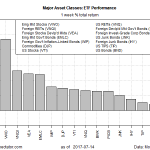In Unraveling Retirement Strategies: Constant-Dollar Spending (4% Rule), I described retirement funding strategies like the “4% Rule” that base portfolio spending on a calculation made at the beginning of retirement that remains unchanged in real dollars regardless of how the household’s finances unfold over time.
Constant-dollar spending is like the Stephen Colbert joke about a man whose beliefs are constant. He believes the same thing on Thursday that he believed on Tuesday … no matter what happened on Wednesday.
That doesn’t work well for retirement planning, either.
Variable-spending strategies are similar to constant-dollar strategies in that they spend periodically from an investment portfolio but differ in that they spend a periodically updated amount based on portfolio performance – they spend more in good markets and less in bad markets.
This is a huge difference. We have two basic choices in portfolio-drawdown strategies: spend a predictable amount annually and risk depleting our portfolio or spend an unpredictable, possibly painful, amount annually to avoid portfolio depletion.
Spending strategies, including these two, explore ways to draw down a portfolio without outliving it but they do so without considering the expense side of the equation.
Regardless of which of these strategies you choose, you will spend the amount you need to spend after retiring. If you need a kidney operation or a new roof or a check for the IRS, you will pay for those things regardless of what your spending strategy recommends. That will increase your chances of outliving your savings but that risk isn’t considered by these “income-side” strategies.
There are many variable spending strategies. I recently attended a webinar in which Wade Pfau identified a half dozen of the better known and in Making Sense Out of Variable Spending Strategies for Retirees[1] he compares several more.
Joe Tomlinson, Steve Vernon, and Wade Pfau recently recommended using the spending percentage for Required Minimum Distributions (RMDs) from qualified retirement accounts[2]. Vernon provides a summary of the study in “How to Pensionize Any IRA or 401(k).”[6]
RMD is based on the assumption of a retiree and a spouse 10 years younger. Retirees closer in age to their spouse can perhaps use the Modified RMD strategy and spend 10% more. Your investment company will calculate RMDs for your qualified retirement accounts when the time comes or you can find a calculator online.[3] You are required by tax law to use these calculations on tax-deferred retirement accounts but you can, of course, use them on all types accounts if you choose.
Another strategy is to spend a fixed percentage, say the same 4%, of the new portfolio balance each year, though the safe spending rate actually increases as life expectancy decreases. It makes more sense to spend that gradually-increasing percentage of one’s current portfolio balance each year than to always spend a fixed percentage of a changing portfolio balance. It approaches 10% late in retirement but grows slowly at first.
Most Americans are eligible for Social Security benefits so most have a floor. It may not be an adequate floor in the event that your portfolio is depleted, but it is a floor. The variable spending strategies and the constant-dollar strategies, therefore, technically manage the upside portfolio of a floor-and-upside strategy and will rarely be a standalone strategy.
I recommend, once again, reviewing this strategy in Pfau and Jeremy Cooper’s The Yin and Yang of Retirement Income Philosophies[4]. I particularly recommend the introduction to the work of Blanchett, Mitchell, and Frank[6] on dynamic spending at the end of the variable spending strategies review. Their strategy periodically updates the critical assumptions of a retirement plan. (Frankly, I don’t see a rational alternative.)
It effectively says, “When the road in front of you turns or ends, modify your car’s behavior accordingly.”
A light pole oddly stood in the middle of the Sears gravel parking lot in my hometown. Some wise person had painted two arrows on the pole curving away in opposite directions. Below the arrows were the words, “Turn. Go left or right.”
Sounds like sage advice.












Leave A Comment